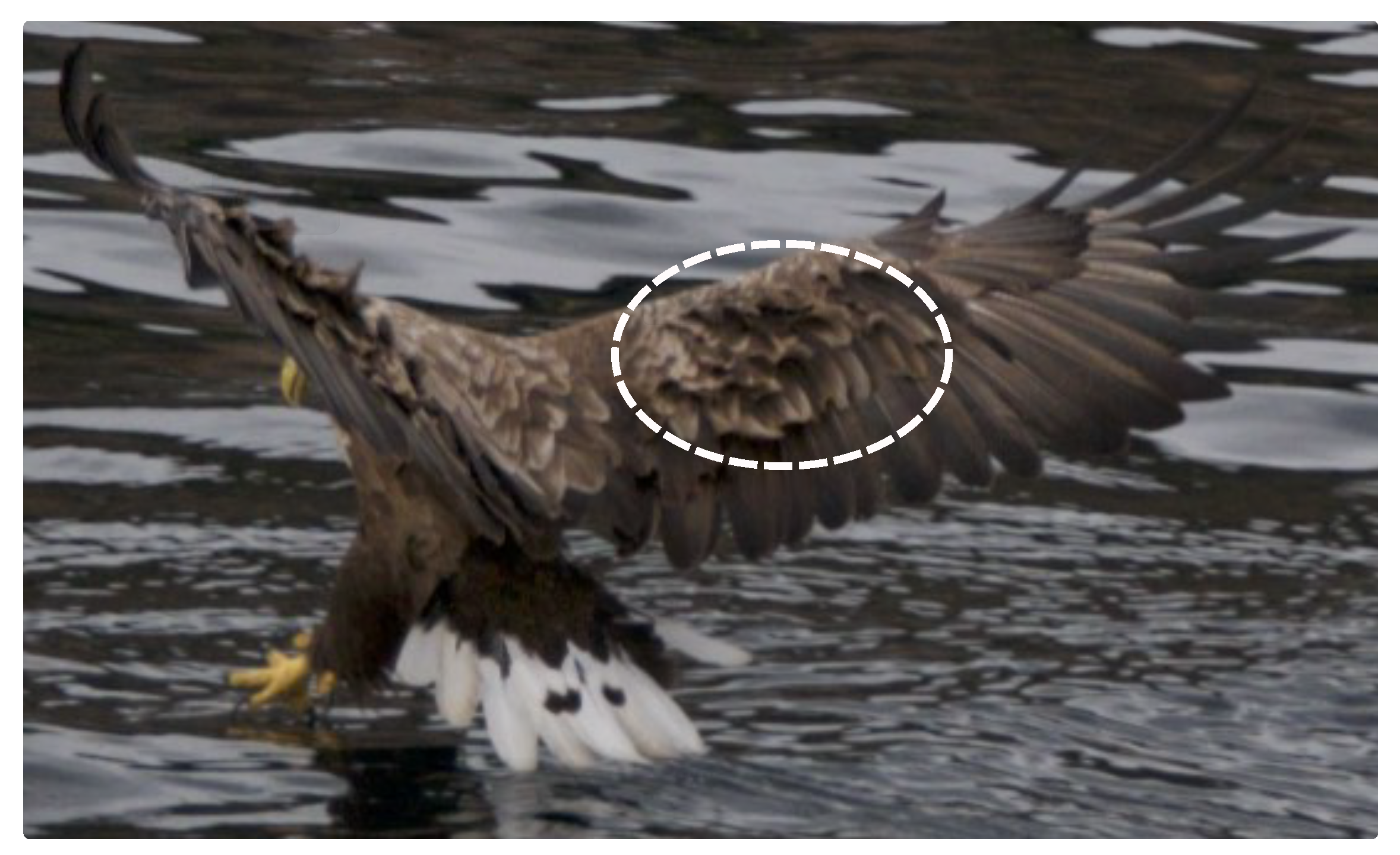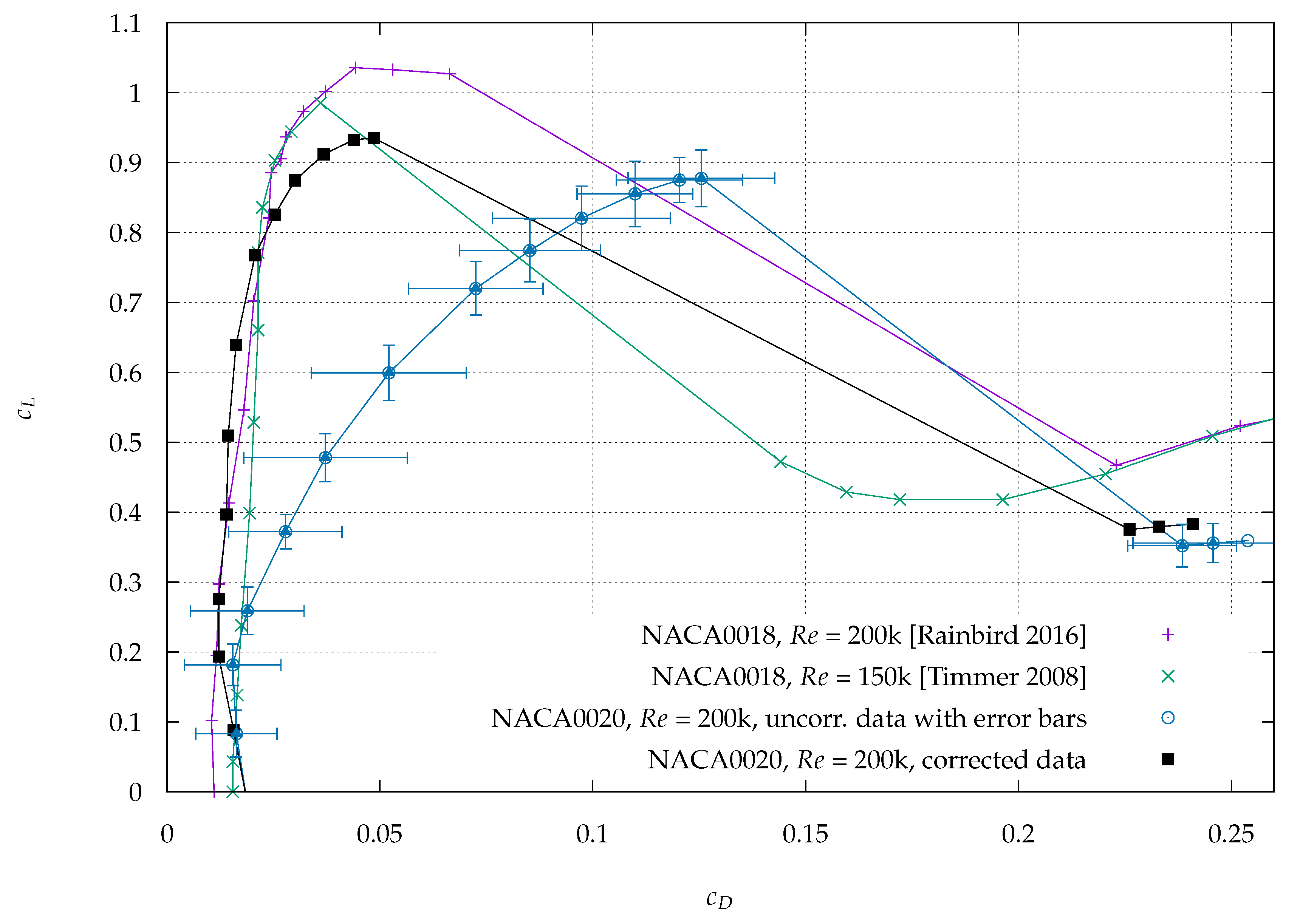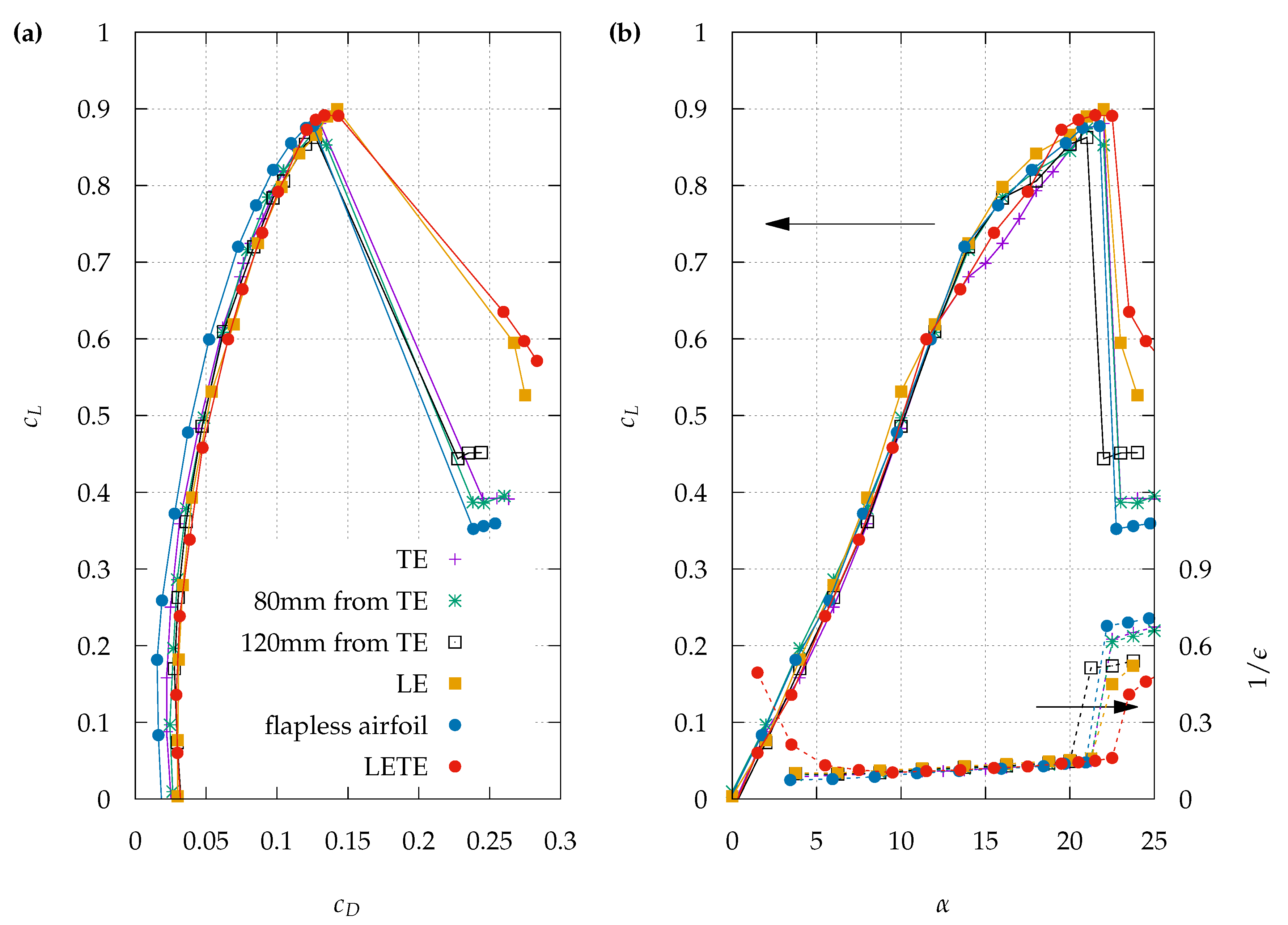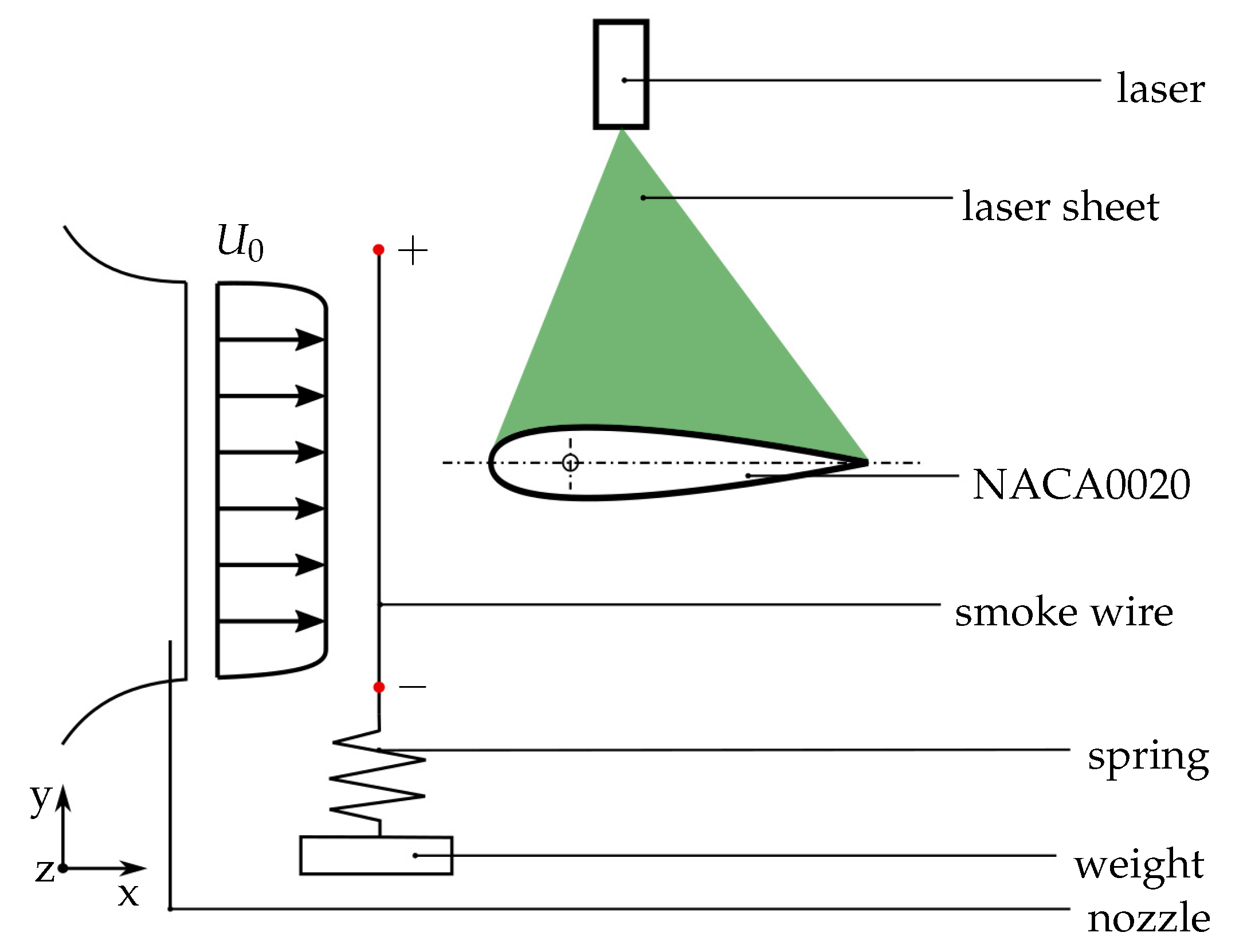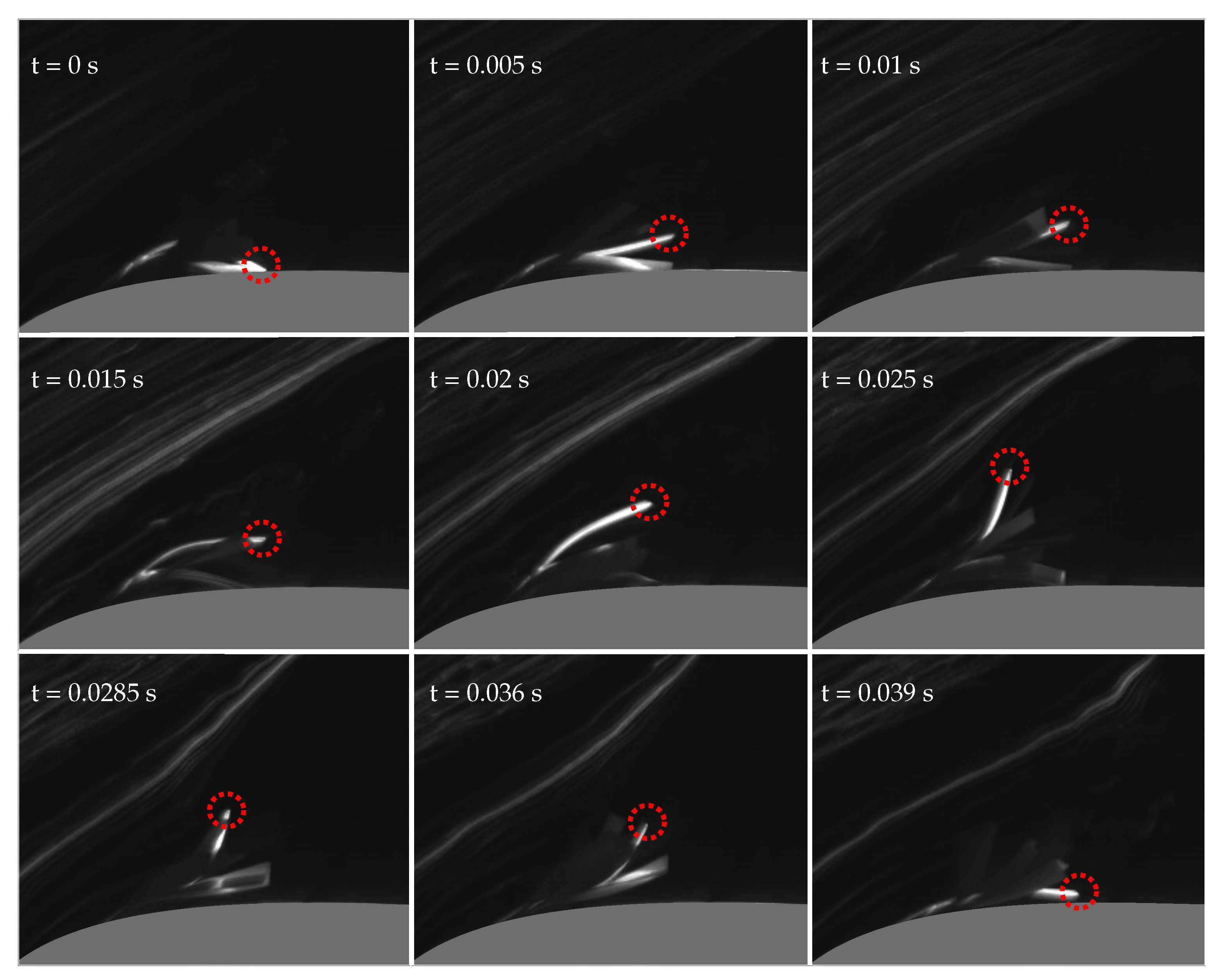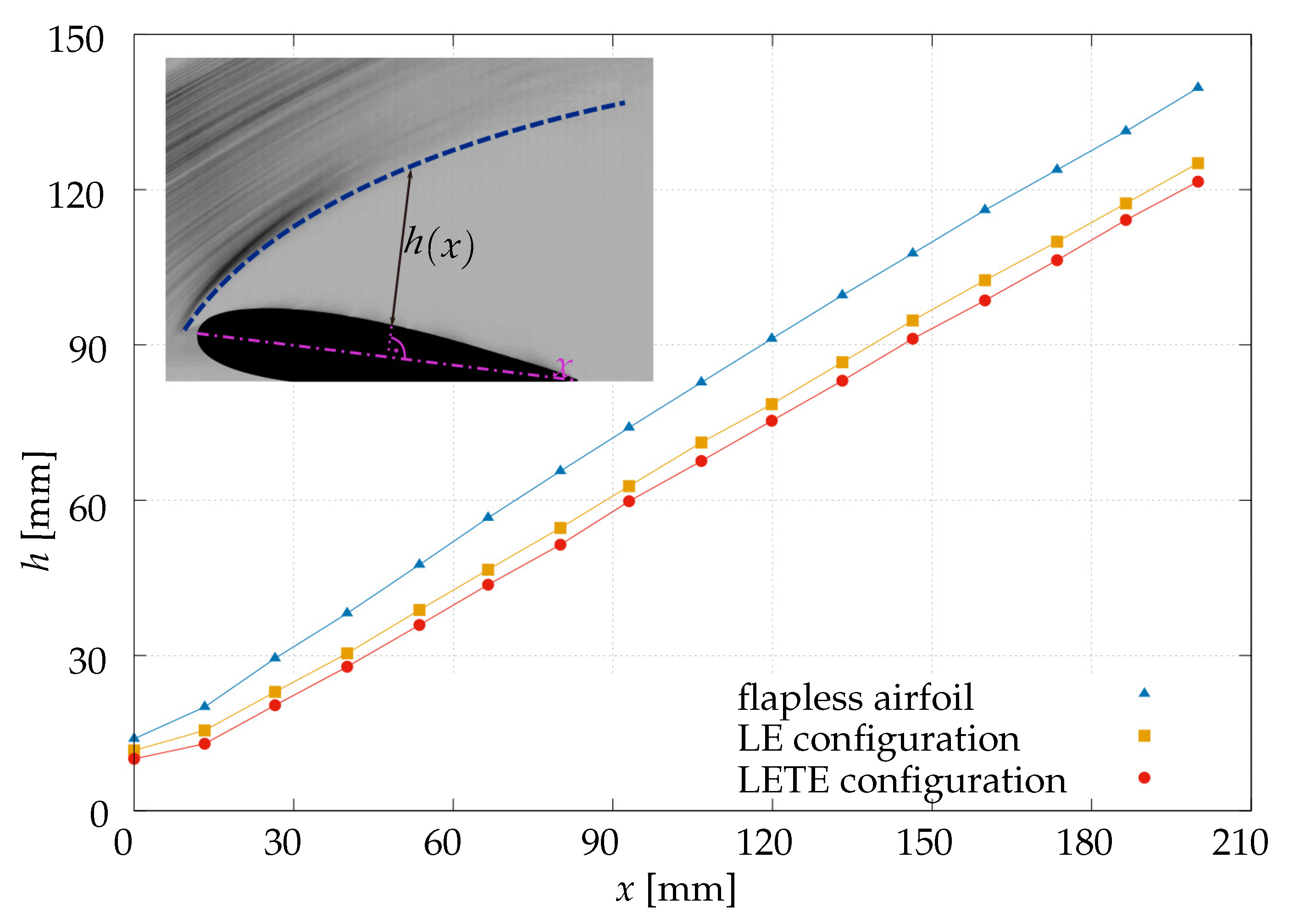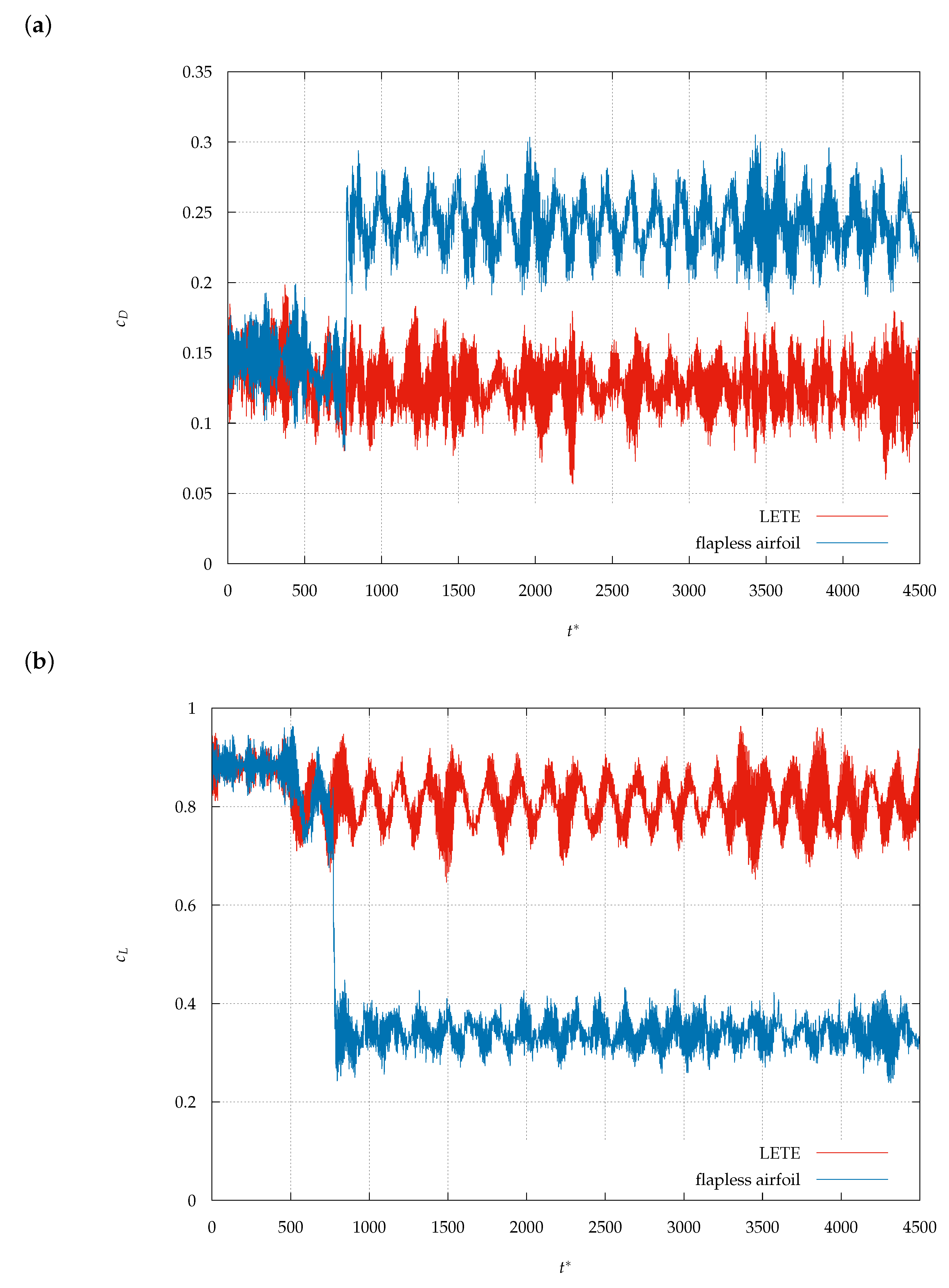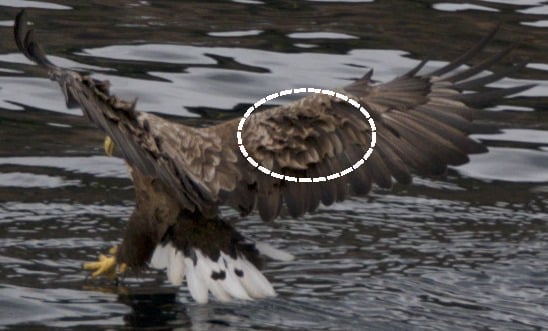1. Introduction
Passive feathers on the wings of birds provide one possibility to control flow separation in critical flight conditions, such as strong gusts or landing maneuvers [
1].
Figure 1 shows the interaction of feathers for a white-tailed eagle trying to catch prey. In order to slow down, the bird increases the angle of attack of its wings. This could potentially lead to flow detachment starting from the trailing edge of the wing, which is known as stall. In this situation, self-adaptive feathers rise and prevent further detachment towards the leading edge of the wing. This interaction between feathers and flow allows for better control of lift at high angles of attack. This positive effect on the lift coefficient could be adopted for technical applications by replacing feathers with flexible flaps [
2,
3,
4,
5,
6,
7]. Examples for usage include small wind turbines, where strong gusts could lead to sudden drops in lift and therefore induce strong mechanical loads.
Table 1 shows a summary of the previous publications on this topic. Based on this overview, the main influencing factors of flap performance are: (1) flap length, (2) flap shape, (3) flap position, (4) number of flap rows, and (5) flap material.
The effective flap length relative to the chord length
c of the profile is in the range of
and
. Brücker and Weidner [
8] showed that a flap length of over
provided no positive effects. On the one hand, short flaps do not provide enough interaction with the flow to avoid stall. On the other hand, very long flaps cause a chaotic flutter and thus a decrease in lift. In a more detailed investigation about chaotic motion, Meyer [
2] reported that the lift increase depends on the maximum angle between the flap and the profile surface. A positive effect on the lift coefficient was observed with an angle of up to 60
. Larger values caused a chaotic motion of the flaps, which terminated the positive effect on the lift. In order to prevent flutter motion or fall-over of the flaps, their length, thickness, and material properties, such as bending stiffness, are crucial.
Kernstine et al. [
4] and Johnston et al. [
6] reported additional drag on airfoils caused by flaps. This is in contrast to Liu et al. [
9], who reported significant reduction in drag. In order to reduce the negative side effects of drag increase, Meyer [
2] suggested changes in the flap shape. In an experiment with V-shaped flaps, he achieved a lift coefficient increase, while the drag coefficient was smaller compared to those of other flap shapes.
Arrivoli and Singh [
3], Meyer [
2], and Kernstine et al. [
4] investigated the influence of the flap row position on a profile. Since these studies used different profiles (flat plate, sailplane profile, and NACA profile), the optimum flap positions were also different. Therefore, a general superior flap position can not be derived. Furthermore, the applied flaps were rigid or flexible, which suggests individual consideration of each study. The number of rows and its impact on lift coefficient was discussed by Meyer [
2] and Hafien et al. [
10]. Three rows increased the lift coefficient by up to 21% compared to a flapless profile. It seems that increasing the number of rows can prevent the flow separation more effectively. Another important factor for the placement of the flaps is the prediction of the flow separation point. Gault [
11] and Bak [
12] reported that the ratio of airfoil thickness to chord length has an impact on whether the separation starts from the trailing or leading edge. The study of Gault [
11] delivered information for a broad range of NACA profiles and inflow Reynolds numbers from
to
. Bak [
12], on the other hand, offers a basic understanding for different stall characteristics. While the trailing-edge stall usually appears on thick profiles, the leading-edge stall is caused by a bursting laminar bubble at the leading edge.
Table 1 summarizes the flap materials used in recent research. They all have a low flap weight in common. Meyer [
2], Schlüter [
5], and Johnston and Edwards [
6] used rigid flaps made of aluminum, PET, carbon fiber, or polyester. In the cases of flexible flaps, recent publications used aluminum foil [
4], silicone elastomer [
8,
13], and cellulose acetate [
3]. Flexible flaps produce less drag than rigid ones due to their better adaption to curved surfaces, such as NACA profiles [
3,
8]. Furthermore, they could lead to noise reduction. Kamps et al. [
13] and Talboys et al. [
14,
15] investigated elastic flaps on the downstream side of a cylinder and airfoil in cross flow. Compared to profiles without flaps, they were able to reduce noise. This effect may have potential on small wind turbines in order to reduce sound emissions. In addition to the noise reduction, Talboys and Brücker [
14] reported, in their study, on the shear layer stabilization effect that is caused by the trailing flaps on the suction side of the airfoil. This effect could also lead to enhanced airfoil performance.
This literature overview shows the benefits of flaps for a wide range of Reynolds numbers and the potential for technical applications. While the positive effect of the self-adapting mechanism is mentioned in the literature [
3,
4,
8,
9,
16], there is only one study (by Kernstine et al. [
4]) of elastic flaps with regard to lift and drag improvements. Because this study focuses on aluminum foil, there is a demand to investigate other elastic materials, since aluminum foil has the disadvantage of plastic deformation, which can be caused by strong gusts. This permanent deformation would negatively affect the aerodynamics of the airfoil. Hence, the main focus of this study will be the investigation of silicone flaps. Furthermore, experiments will be performed with a constant Reynolds number, as well as with varying inflow velocity, to investigate the influence of gusts. Drag and lift coefficients will be measured to conclude the benefits of flexible flaps.
3. Results and Discussion
3.1. Literature Validation and Uncertainty of Measurement
In the following section, results from the flapless profile of the present study and from other publications are compared in order to validate the measuring system. Unfortunately, no other data sets of polars were found for same profile and Reynolds number. Therefore, results of an NACA0018 are included with similar
values by Timmer [
19] and Rainbird [
20] (see
Figure 6). For this comparison, a correction method is employed that was proposed by Du et al. [
21] for open-jet wind tunnels. This method is based on Garner et al. [
22], and considers the effect of streamline curvature. The cause for this effect is the diverging jet, which expands even more with an increasing angle of attack of the airfoil. The correction equations are as follows:
Hereby,
is a function of the uncorrected lift coefficient
, chord length
c, and wind tunnel nozzle height
h.
is a function of the Mach number
and has a value of approximately 1 because of the low inflow velocity during the experiments. The corrected drag coefficient
considers the geometry of the nozzle and is calculated as follows:
Figure 6 shows a good agreement between the literature and the experimental data. However, the lift coefficient in our study is underestimated by up to 10% compared to Rainbird [
20]. The comparison of our study with Timmer et al. [
19] shows the same trend, with a difference of up to 5%. Rainbird and Timmer both used a closed section of measurement, which is assumed to be the main reason for this difference. A similar observation between closed and opened sections of measurement was reported in the study of Du et al. [
21]. Furthermore, it is assumed that the slight vibrations of the profile are the cause of standard deviation, which is presented by the error bars in
Figure 6. The general purpose of standard deviation is to represent random error of the measurements. At the critical angle, the deviation for
is ±5%; for
, it is ±8%. Despite the standard deviation, repeated experiments of three test series showed an error between mean values of less than 1%.
For our measurements, the airfoil was placed in the center of the wind tunnel nozzle. The flow is uniform and has a turbulence intensity of less than 0.1%. The major impact on accuracy of the calculated coefficients resulted from velocity, force, and density measurements. The load cells of the force balance have a deviation of ±0.04 N. The temperature and ambient pressure needed for density calculation have a deviation of ± and ±100 , respectively. The velocity at the nozzle outlet is measured through the pressure difference between the nozzle and the environment, and has a deviation of ±0.073%. To guarantee a constant velocity, the number of revolutions per minute of the fan are kept constant (about 460 min). Finally, an overall calculation of the uncertainty propagation for multiple variables delivers a maximum deviation of ±1.0% for and ±4.2% for . The estimated measurement uncertainty for the lift coefficient is rather constant, while the relative error of the drag coefficient is largest for angles smaller than 6. This is due to the constant deviation of the load cells and the small measured forces at low angles. With increasing angle (6), the estimated measurement uncertainty drops to less than 1.0%.
It should be noted that uncorrected data (drag, lift, and angle of attack) are presented in this publication; there are two reasons for this: (i) The correction method supposes two-dimensional flow. For flapped configurations at critical angles and in the stall region, this is not guaranteed. (ii) There is more than one correction method (e.g., [
17,
22]). Therefore, the uncorrected data can be used by other authors and adapted to their needs. Furthermore, the aim of our study is to present the trends of the lift and drag coefficients, which are still guaranteed by the uncorrected data.
3.2. Steady Flow Conditions
Figure 7a shows a lift–drag polar for one silicone flap row for four different positions on the NACA0020 profile and a combination of two rows at the leading and trailing edges.
Figure 7b gives the reciprocal lift-to-drag ratio
and lift coefficient against the angle of attack. Hereby, the reciprocal lift-to-drag ratio is calculated with:
is an essential parameter for qualification of rotor blades on a wind turbine because of its influence on the power output. Hence, reciprocal values were added for better presentation of the curve; they also allow a more detailed analysis with respect to the angle of attack. In both diagrams, data of a profile without flaps are included for reference.
For angles lower than 15, the flapless profile generates up to 50% less drag than other flapped configurations. The slight increase in drag with flaps compared to the baseline airfoil can be explained by the surface unevenness caused by the flaps. The flap row configurations of trailing edge (TE), 80 from TE, and 120 from TE offer no benefits in the pre-stall region. The maximum lift coefficient in the pre-stall region increases only for two configurations: Flap row at the leading edge and flap row at the leading and trailing edges of the airfoil. For these two cases, a lift coefficient increase of up to 2.5% and drag coefficient increase of 12% are observed at the critical angle. The additional drag at the critical angle results from raised flaps that cause higher flow resistance. Nevertheless, considering the angle delay that is achieved by the leading-edge (LE) and leading-edge–trailing-edge (LETE) configurations, a comparison of these configurations at the critical angle with the same angle of the flapless profile shows an increase of up to 2.5 times for and a reduction by 40% for .
Furthermore, the reciprocal value of is constant for all configurations between angles 6 and 20. Because 1/ becomes very large at small angles, no values were considered for angles less than 3, except for the LETE configuration for the purpose of example presentation. The divergence of 1/ results from very small lift coefficients at low angles of attack. The LETE configuration has an minimum at 4, which is a consequence of the flaps. Because of the two flap rows on the upper airfoil surface, the drag coefficient is slightly higher, while the lift coefficient value remains rather small.
Compared with the flapless airfoil, the flow separation was delayed by approximately
for the LE configuration and by 1
for the LETE configuration. During the experiment, the flaps started to move permanently at the critical angle. At lower angles of attack, there was almost no interaction with the flow. At the critical angle of attack, it seems that the slightly raised flaps influence the backflow region, which was also observed by Brücker and Weidner [
8]. Despite that, it should be noted that the raising of the flaps in a wind tunnel at the critical angle is less distinctive in comparison with the water channel results in [
8], which is likely a consequence of the density ratio difference between the fluids and flaps.
The positive effects of the flapped configurations can especially be seen in the stall region. Depending on the flap row position, the lift coefficient after flow separation increases by up to 50% (for the LE and LETE configurations). This lift increase is in good agreement with the results of Hsiao et al. [
18], who reported a lift enhancement of between 50% and 70% for the stall region. Moreover, the increasing lift of the LETE configuration in the stall region affects 1/
, as it has the lowest values from all configurations. For the configurations TE, 80
from TE, and 120
from TE, the lift coefficient increase during the stall is between 10% and 20%, respectively. From the
evaluation of the LE, LETE, and 120
from TE configurations, it seems that the closer the flaps are placed to the leading edge, the better the airfoil performance in the stall region is.
3.3. Smoke–Wire Flow Visualization
3.3.1. Experimental Setup
Because the force balance results allow a limited explanation regarding the acquired results, a visualization of the flow was done. This technique provides a better possibility of comparison and evaluation of the flow around the airfoil with and without flaps.
The experimental setup is illustrated in
Figure 8. This smoke–wire technique is adapted from Kirk et al. [
23]. The NACA0020 profile was mounted in the test section without end plates in order to see the flow around the airfoil surface. A vertical Nichrome wire with a thickness of
was placed
in front of the profile. During the inflow, the wire was stabilized by a spring and weight that damped the vibrations caused by the flow. Furthermore, the wire was connected to a power supply unit that provided 30
and 5
direct current. On the wire, a manual application of a mixture (Glycerin 70% and water 30%) was done with a cotton swab. The inflow velocity of 15
was adjusted. In order to visualize smoke, the vertical wire was placed on the same plane as the laser sheet, which was in the middle of the airfoil. The laser sheet was generated by a 10 mJ Nd:YLF high speed laser.
The pictures of the illuminated smoke flow were taken by a high-speed camera (Phantom V12.1) that was placed perpendicularly to the laser sheet. The frame rate was 2000 and exposure time 70 , with a resolution of 1280 × 800 (35.5 pixels per 1 ). The images were averaged in order to visualize the flow field and the recirculation region. Only steady flow conditions can be investigated with this setup due to the short smoke generation time of less than .
3.3.2. Flow Visualization Results
Figure 9 shows the post-processing procedure, as well as the possibilities and limits of this visualization technique. For example, a flapless airfoil was selected with
= 20
. Considering the literature [
17,
23], at this angle, turbulent separation is formed and proceeds to move from the trailing edge towards leading edge, which makes it a convenient example.
Figure 9a shows a snapshot of the visualized flow around the NACA0020 profile. Since the size of the turbulent separation region is time-dependent, it is necessary to generate an averaged flow field (see
Figure 9b) in order to evaluate the results. The averaged flow field for this configuration consists of five different measurement series, with each containing up to 200 snapshots. With this approach, it was possible to confirm the repeatability of the observed results. At last, the averaged flow field was inverted and the contrast was increased to improve the visualization (see
Figure 9c). Additionally, a mask of the NACA0020 profile was added for a better differentiation between the fluid flow and the airfoil.
With this setup, it is not possible to visualize the boundary layer at the airfoil surface. As seen in
Figure 9c, the turbulent separation is not directly visible. The reason is the smoke, which flows only around separation regions. Moreover, the vortices that guide the smoke into the turbulent separation favor the mixing process of smoke and air, which additionally limits the visualization of the separation regions (see
Figure 9c). Nevertheless, despite not seeing the mechanism inside the separation region, it is still possible to visualize the laminar flow around the airfoil. Thus, the size and location, especially for the turbulent separation region, can be visualized indirectly, as the contours around it are visible. However, the discussion in this chapter focuses on flap interaction in the deep stall region. With the current setup, the boundary layer cannot be visualized, and no clear differences were observed for the airfoil with and without flaps in the pre-stall region.
Figure 10 shows the flow field for a flapless profile and the flapped configurations LE and LETE at
= 25
. The turbulent recirculation region is formed above the airfoil. For a flapless airfoil, the recirculation region appears to be larger than in the cases of the LE and LETE configurations. The flap movement interval (see
Figure 10b,c) indicates a backflow from the trailing edge towards the leading edge. However, unlike the leading-edge flap, the trailing-edge flap is permanently turning over (see
Figure 10c). Because of the force balance measurements, the increased performance of this configuration is known during deep stall, and it seems that the turn-over movement is crucial for the airfoil performance. Unfortunately, it was not possible to visualize the flow in the separated region. It is assumed that the turned-over flaps at the trailing edge influence the intensity and velocity of the separated flow at the upper surface of the airfoil.
Figure 11 presents snapshots of the flap motion for one cycle. The cycle includes an upward motion of the flap from the airfoil surface and a pull-back motion. The backflow inside the turbulent separation region raises the elastic flaps from the airfoil surface so they reach into the laminar flow. At this point, elastic flaps are pushed back by the aerodynamic forces of the ambient flow. The push-back motion appears to be similar to a whip movement, as it was repeatedly observed to be up to three times faster than the upward motion. It is supposed that this movement pushes the vortices down towards the airfoil surface. As a consequence, the instantaneous laminar flow leans more towards the airfoil and the recirculation region shrinks, which was observed previously in
Figure 10. Due to the conservation of momentum, the pushed-down vortices generate lift.
Figure 12 summarizes the results of the turbulent separation regions around the NACA0020 profile for the flapless airfoil, LE, and LETE configurations at
= 25
. This figure allows a more precise evaluation of the distance
h between the separation line and the airfoil surface at position
x of the chord line. The evaluation is performed manually with a graphic editor due to the need for individual contrast adaption of each configuration. Nevertheless, the deviation of this method is about 1 px, which provides a proficient accuracy. The distance between the separation line and the airfoil surface increases with growing
x for the flapped and flapless configurations. For the LE and LETE configurations, the separation lines show smaller distance differences compared to those of the flapless profile. The height difference of the flapped configurations is constant and does not increase towards the trailing edge of the profile. With the current method, it was not possible to visualize and evaluate the vortices in the turbulent separation region, as they seem to influence the lift coefficient in deep stall. Thus, the recirculation size evaluation delivers no explanation for the lift coefficient difference between the LE and LETE configurations in deep stall.
3.4. Gust Simulation
Figure 13 shows results of drag and lift coefficients in a gust simulation for the NACA0020 profile with and without flaps. The flapped profile has flaps at the leading and trailing edges, as this was the best configuration under steady flow conditions. The angle of attack is set slightly below the critical angle. For the flapped configuration, the angle is approximately
, and for the flapless profile, it is about
. The coefficients
and
in
Figure 13 depend on dimensionless time
:
The coefficients were measured for a time interval of
t = 60
. Until
≈ 750, the flow is steady with an adjusted velocity
= 15 m/s. After
≈ 750, gusts are initiated by the rotating plate and the flow becomes transient. The average flow velocity reduces to 14 m/s. This is due to the increase in flow resistance of the rotating plate in the wind tunnel. The resulting sinusoidal velocity profile has a frequency of
and a peak-to-peak amplitude of 1 m/s. The lower flow velocity, and thus the lower Reynolds number, leads to a reduction in the critical angle of attack [
5]. This effect triggers flow separation.
The drag coefficients for a profile with and without flaps are presented in
Figure 13a. The drag coefficient of the profile without flaps increases suddenly after gust initiation. This indicates that stall is occurring, which raises the drag coefficient by 38%. In contrast, the average drag coefficient for the profile with flaps decreases slightly by only 13%. As mentioned above, this reduction is due to the lower flow velocity resulting from the rotating blade in the wind tunnel. Lift coefficients for the NACA profile with and without flaps are shown in
Figure 13b. While gusts reduce the lift coefficient of the flapless profile by more than 60%, the flapped profile is only marginally influenced, with a reduction of about –5%. It should also be noted that during the gust initiation, drag coefficient fluctuations are similar for the flapped and flapless profiles, while the lift coefficient fluctuations increase. For the flapped profile, these lift coefficient fluctuations are two times higher than those of the flapless profile. This significant difference probably results from increasing dynamic loads on the profile at the critical angle and thus stronger back-and-forth movements of the airfoil and mounting.
For the flapless profile, the flow separation set in shortly after the lowest velocity was reached (see
Figure 13a). This outcome was observed repeatedly during gust simulations. Since stall tends to set in earlier with decreasing Reynolds numbers, this velocity reduction destabilizes the flow and causes the onset of flow separation on the flapless airfoil. Flap rows at the trailing and leading edges reduce the impact of the gusts through interaction with the flow. The main result of this is the prevention of precociously appearing flow separation.
4. Conclusions
The aim of this study was to investigate the drag and lift for an NACA0020 profile with and without elastic flaps. Experimentally, the drag and lift forces were measured using a force balance in a Göttingen-type wind tunnel. Five different flap configurations were investigated in steady states and one configuration in transient flow.
In the first part, flaps were investigated using steady flow conditions. Using a single flap row on the profile, a significant increase in lift was observed in the post-stall region, and stall was delayed by . The leading-edge flap configuration achieved the best performance. Furthermore, in the pre-stall region, the drag coefficient is noticeably higher in comparison to that of the flapless profile. This increase resulted from additional friction losses due to the flaps on the profile surface. Since the flow separation develops from the trailing edge, another flap row was added at the end of the NACA0020 profile. The two-flap row combination offered the most beneficial impact on the results with respect to post-stall lift increase and stall angle delay.
In the second part, a smoke–wire visualization technique was used for a better understanding of the airfoil performance improvement by the flaps in the deep stall region. Hereby, a comparison of flapless airfoil, flaps at the leading edge, and flaps at the leading and trailing edges was done. It was shown that the leading-edge flaps push the averaged flow field towards the airfoil surface. This causes a reduction of the turbulent recirculation region size and improves the performance of the airfoil.
Finally, experiments were performed for the NACA0020 profile with and without flaps under transient flow conditions. Flaps were placed at the leading and trailing edges. The angle of attack was set to its critical value. Once the gusts started, the drag coefficient of the flapless profile increased by nearly 60%, while the lift coefficient fell significantly. The combination of gusts and the critical angle lead to stall. In contrast, the flapped profile offered a significantly better performance. After initiating the gusts, drag and lift decreased only by about 6% and 5%, respectively. This indicates that stall is prevented by the NACA profile with flaps. As soon as the stall starts to develop at the leading edge of the profile, the flaps rise from the surface and prevent further spreading of the flow separation.
For a better understanding of the interaction between flaps and flow under stall conditions, future work will focus on PIV measurements of the near-wall flow. Furthermore, fiber-reinforced flap materials suitable for higher loads will be investigated because they could be potentially used with small wind turbines.
